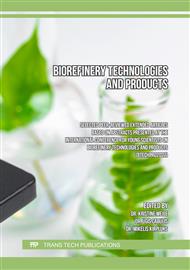[1]
S.K. Najafi, Use of recycled plastics in wood plastic composites - A review, Waste Management. 33 (2013) 1898-1905.
DOI: 10.1016/j.wasman.2013.05.017
Google Scholar
[2]
I. Turku, T. Kärki, A. Puurtinen, Durability of wood plastic composites manufactured from recycled plastic, Heliyon. 4(3) (2018) e00559.
DOI: 10.1016/j.heliyon.2018.e00559
Google Scholar
[3]
A.M. Adel, Z.H. Abd El-Wahab, A.A. Ibrahim, M.T. Al-Shemy, Characterization of microcrystalline cellulose prepared from lignocellulosic materials. Physicochemical properties, Carbohydrate Polymers. 83(2) (2011) 676-687.
DOI: 10.1016/j.carbpol.2010.08.039
Google Scholar
[4]
M. El-Sakhawy, M.L. Hassan, Physical and mechanical properties of microcrystalline cellulose prepared from agricultural residues, Carbohydrate Polymers. 67(1, 2) (2007) 1-10.
DOI: 10.1016/j.carbpol.2006.04.009
Google Scholar
[5]
G. Joshi, S. Naithani, V.K. Varshney, S.S. Bisht, V. Rana, P.K. Gupta, Synthesis and Characterization of Carboxymethyl Cellulose from Office Waste Paper: A Greener Approach Towards Waste Management, Waste Management. 38(1) (2015) 33-40.
DOI: 10.1016/j.wasman.2014.11.015
Google Scholar
[6]
D. Trache, M.H. Hussin, C.T.H. Chuin, S. Sabar, M.R.N. Fazita, O.F.A. Taiwo, T. M. Hassan, M.K.M. Haafiz. Microcrystalline cellulose: Isolation, characterization and bio-composites application - A review. Int J Biol Macromol. 93 (2016) 789-804.
DOI: 10.1016/j.ijbiomac.2016.09.056
Google Scholar
[7]
H. Håkansson, P. Ahlgren, Acid hydrolysis of some industrial pulps: Effect of hydrolysis conditions and raw material, Cellulose. 12(2) (2005) 177-183.
DOI: 10.1007/s10570-004-1038-6
Google Scholar
[8]
M. Maskavs, M. Kalnins, M. Laka, S. Chernyavskaya, Physicomechanical Properties of Composites Based on Low-Density Polyethylene and Cellulose-Containing Fillers, Mechanics of Composite Materials. 37(2) (2001) 159-166.
DOI: 10.1023/a:1010677704586
Google Scholar
[9]
A. Ashori, A. Nourbakhsh, Performance properties of microcrystalline cellulose as a reinforcing agent in wood-plastic composites, Composites: Part B. 41 (2010) 578-581.
DOI: 10.1016/j.compositesb.2010.05.004
Google Scholar
[10]
M. Laka, S. Chernyavskaya, G. Shulga, V. Shapovalov, A. Valenkov, M. Tavroginsakya, Use of Cellulose-Containing Fillers in Composites with Polypropylene, Materials Science (Medžiagotyra). 17(2) (2011) 151-154.
DOI: 10.5755/j01.ms.17.2.484
Google Scholar
[11]
A. M. Youssefa, M. S. Hasaninb, M. E. Abd El-Azizc, O. M. Darweshd. Green, economic, and partially biodegradable wood plastic composites via enzymatic surface modification of lignocellulosic fibers. Heliyon, 5 (3), 2019, eO1332.
DOI: 10.1016/j.heliyon.2019.e01332
Google Scholar
[12]
F.P. La Mantia, M. Morreale, Green composites: A brief review. Composites: Part A: Applied Science and Manufacturing Composites. 42(6) (2011) 579-588.
DOI: 10.1016/j.compositesa.2011.01.017
Google Scholar
[13]
J.Z. Lu, Q. Wu, H.S. McNab, Chemical coupling in wood fiber and polymer composites: a review of coupling agents and treatments, Wood Fiber and Science. 32(1) (2000) 88-104.
Google Scholar
[14]
M.M. Kabir, H. Wang, K. T. Lau, F. Cardona, Chemical treatments on plant-based natural fiber reinforced polymer composites: an overview. Composites: Part B Engineering. 43(7) (2012) 2883-2892.
DOI: 10.1016/j.compositesb.2012.04.053
Google Scholar
[15]
J. Jaunslavietis, J. Ozolins, M. Kalnins, G. Shulga, B. Neiberte, A. Verovkins, Recycled paper additive for wood-polymer composite: preparation and characterization, Key Engineering Materials. 850 (2020) 81-86.
DOI: 10.4028/www.scientific.net/kem.850.81
Google Scholar
[16]
Z. Lin, C. Chen, Z. Guan, S. Tan, X. Zhang, A compatibilized composite of recycled polypropylene filled with cellulosic fiber from recycled corrugated paper board: mechanical properties, morphology, and thermal behavior, J Appl Polym Sci. 122 (2011) 2789-2797.
DOI: 10.1002/app.34321
Google Scholar
[17]
X. Zhang, J. Shen, H. Yang, Z. Lin, S. Tan. Mechanical properties, morphology, thermal performance, crystallization behavior, and kinetics of PP/microcrystal cellulose composites compatibilized by two different compatibilizers. J Thermoplast Compos Mater. 24 (2011) 735-753.
DOI: 10.1177/0892705711403527
Google Scholar



